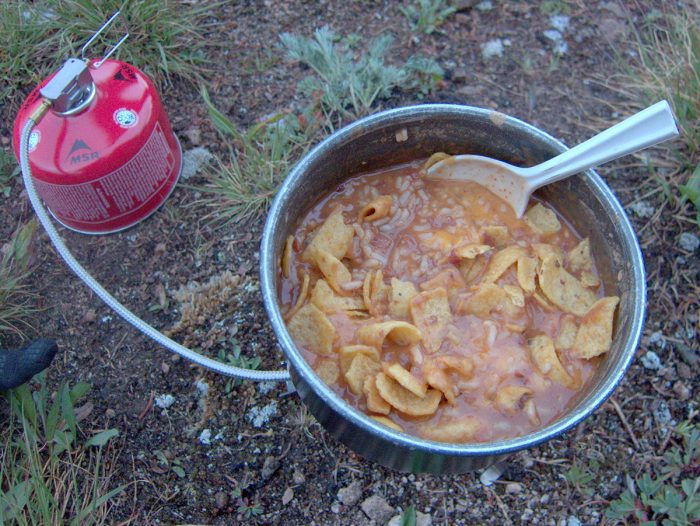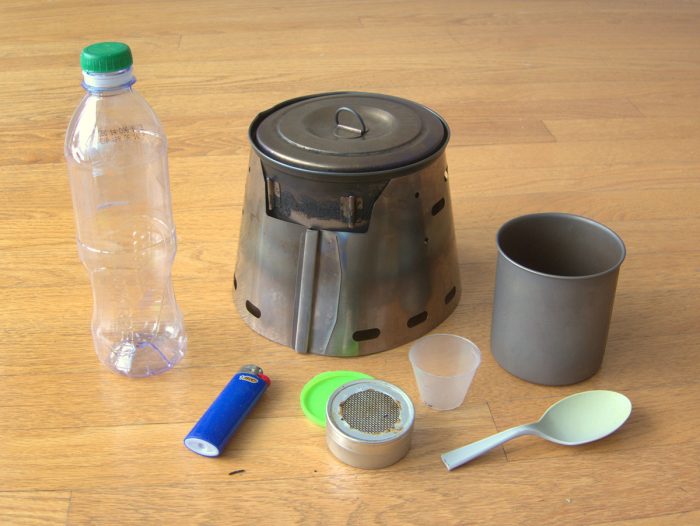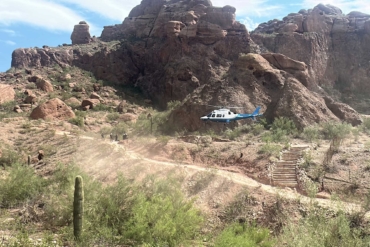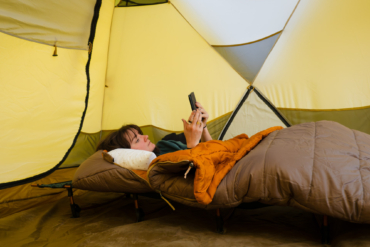During an overnight trip last month in the Colorado Rockies with Andrew Skurka, it was quickly evident to me that he’s not your average backpacker.

A renowned hiker who’s circumnavigated Alaska and the Yukon by foot, Skurka hikes faster than most ultra runners. But more interesting are some of his contrarian ways — what he wears, carries, and eats is often inconsistent with conventional backpacking wisdom. — Sean McCoy
Here, Skurka elaborates on a few of the most unexpected items in his pack.
1. DIY breakfasts and dinners
Commercial freeze-dried meals are convenient and tasty. But at $9 for a 5-ounce dinner, which equates to $29 per pound, they’re financially impractical for a season of backpacking or guided trips. Instead, I have about ten DIY recipes that are much less expensive but are still convenient (e.g., few ingredients, quick at-home prep) and hearty.
For our trip, I brought my most reliable crowd-pleaser: Beans & Rice with Fritos & Cheese. The recommended serving is 5.7 ounces and has 675 calories. Go here for all of my recipes.

2. Breathable trail running shoes
Waterproof hiking boots are my go-to when temperatures are below freezing and the snowpack is “dry.” In Colorado, these conditions normally prevail between October and April.
Otherwise, I prefer breathable trail running shoes. Models like the Salewa Ultra Train (in photo) and La Sportiva Ultra Raptor offer much more support, protection, and durability than most. Compared to boots, trail running shoes are more comfortable out of the box, cooler in summertime temperatures, and lighter weight (which saves energy).
Yes, my feet do get wet from rain, dew-soaked grass, and creek crossings. But, “waterproof” shoes often fail in extended wet conditions, too. In response, I learned to minimize the effects and aftermath of wet feet.

3. Core clothing
Last year for Gear Junkie I wrote about the Core 13, a tight collection of clothing that can be mixed-and-matched to create appropriate clothing systems for all 3-season conditions.
With just these 13 items, you can be properly outfitted for the Grand Canyon in May, Alaska in July, and the new Maine Woods National Monument in October. All 13 are rarely necessary for a single trip. During this outing, I carried only seven, and if the forecast had been drier I would have left the trailhead with only six.

4. Homemade kits for first aid, foot care, and repair
As a new backpacker, I was unable to assemble useful kits for first aid, foot care, and repair. First, I didn’t know what problems to expect. Second, even if I had, I didn’t know what supplies would best address them. So I settled on pre-assembled commercial kits.
By backpacking a lot and guiding trips, I gained more perspective on these topics. Now, I much prefer homemade kits: they’re less expensive long-term; custom tailored to my group, activities, and environment; and can include better solutions, like Bonnie’s Balm and Leukotape (rather than the conventional Vaseline and duct tape).
I’ve posted my DIY kits for first aid, foot care, and repair, and have made each kit available as a downloadable PDF and spreadsheet.

5. Alcohol stove
Among long-distance hikers and self-described ultralight backpackers, alcohol stoves are probably the most popular choice. And for good reason: they weigh and cost little, and the fuel is widely available.
For many years I used a homemade alcohol stove. The Dirtbag system, complete with a coffee cup, weighs less than 9 ounces and costs just $22. Although, I recently upgraded to the more expensive Cadillac system, for improved fuel-efficiency, stability, and wind-resistance.

6. Navigation
The accuracy of a GPS handheld unit, to within a few meters, is remarkable. However, these devices rely on batteries, add weight and expense, and often require proprietary mapping packages. Plus, except for geocaching, their accuracy is overkill.

To navigate, both on- and off-trail, I primarily use a time-tested system: topographic maps, a magnetic compass, and a watch. This setup is fast and perfectly functional; it performs without batteries and even after being dropped or submerged. The paper map also provides a much bigger viewing window than any GPS unit.
Normally I carry three types of topographic maps: small-scale detailed maps, a large-scale overview map, and digital maps stored on my smartphone in the event that I lose or get off of my paper maps. With an app like Gaia GPS, I give my smartphone the same functionality as a conventional GPS unit, for the rare instance when I want pinpoint accuracy or when I need to find my location.








